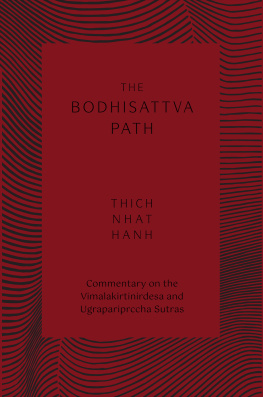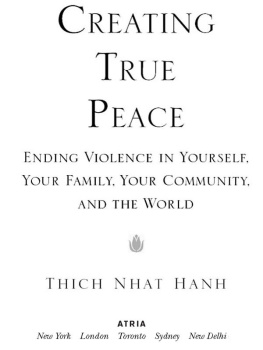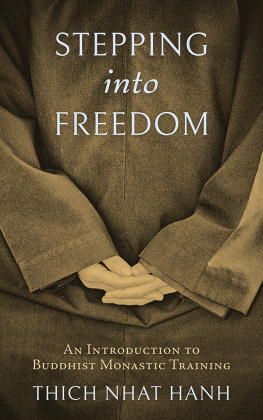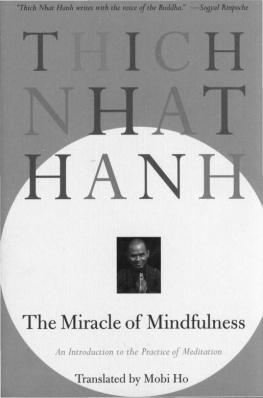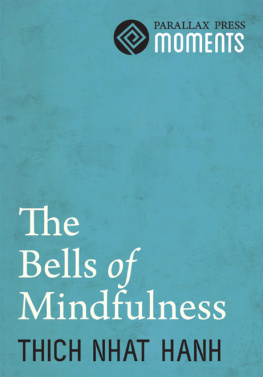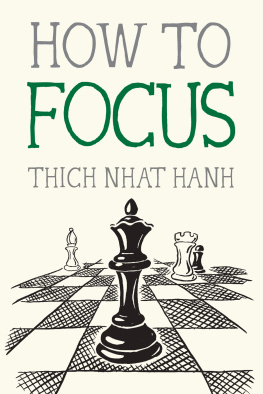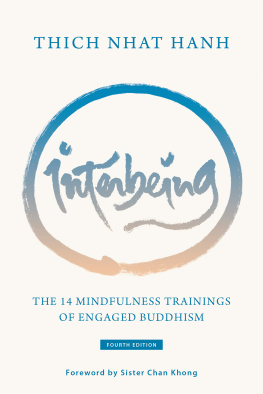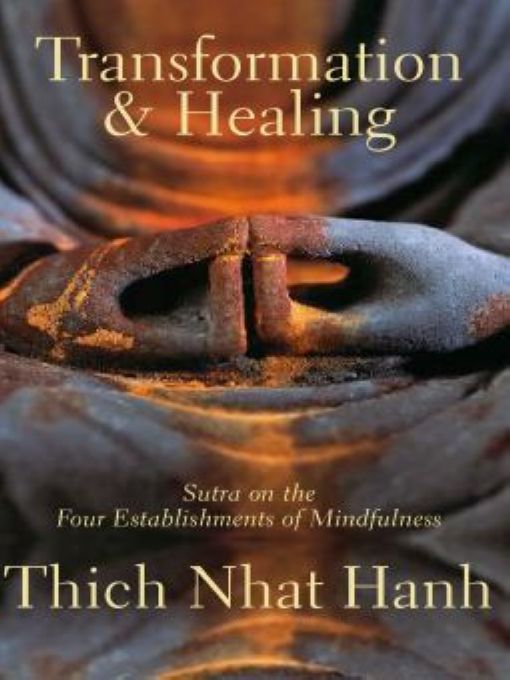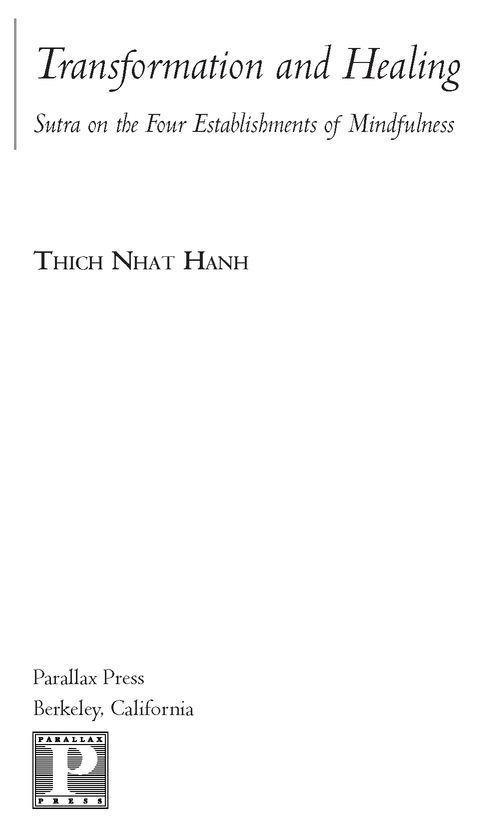Table of Contents
A NOTE ON THE TEXT
The word for a Buddhist scripture, the teachings of the Buddha, is sutta in Pali and sutra in Sanskrit. Because a number of texts, Pali, Sanskrit, and Chinese, are cited throughout the commentary, we use the word sutra as if it were an English word and use the word sutta only when it is part of the proper name of a Pali sutta, such as Satipatthana Sutta or Anapanasati Sutta.
The word satipatthana (Sanskrit: smrityupasthana) is a compound of sati, which means mindfulness or remembering, and upatthana, which means place of abiding, establishment, or application. In Chinese, the title of the sutra is Nian Chu. Nian is to be mindful of, to put ones attention to, or to remember. Chu means either the dwelling place or the act of dwelling, the act of being present, the act of establishing oneself. Nian Chu therefore may be translated as the Four Grounds of Mindfulness or the Four Establishments of Mindfulness.
For ease of use, the text of the original sutra has been kept with the male pronouns, he and his, throughout, although clearly the message is intended for practitioners of any gender. This was done for ease of reading and to keep as close to the original as possible.
Introduction: What Is Mindfulness?
We practice mindfulness in order to realize liberation, peace, and joy in our everyday lives. Liberation and happiness are linked to each other; if there is liberation, there is happiness, and greater liberation brings greater happiness. If there is liberation, peace and joy exist in the present moment. We dont need to wait ten or fifteen years to realize them. Theyre available as soon as we begin the practice. However modest these elements may be, they form the basis for greater liberation, peace, and joy in the future.
To practice meditation is to look deeply in order to see into the essence of things. With insight and understanding we can realize liberation, peace, and joy. Our anger, anxiety, and fear are the ropes that bind us to suffering. If we want to be liberated from them, we need to observe their nature, which is ignorance, the lack of clear understanding. When we misunderstand a friend, we may become angry at him, and because of that, we may suffer. But when we look deeply into what has happened, we can end the misunderstanding. When we understand the other person and his situation, our suffering will disappear and peace and joy will arise. The first step is awareness of the object, and the second step is looking deeply at the object to shed light on it. Therefore, mindfulness means awareness and it also means looking deeply.
The Pali word sati (Sanskrit: smrti) means to stop, and to maintain awareness of the object. The Pali word vipassana (Sanskrit: vipashyana) means to go deeply into that object to observe it. While we are fully aware of and observing deeply an object, the boundary between the subject who observes and the object being observed gradually dissolves, and the subject and object become one. This is the essence of meditation. Only when we penetrate an object and become one with it can we understand. It is not enough to stand outside and observe an object. Thats why the Sutra on the Four Establishments of Mindfulness reminds us to be aware of the body in the body, the feelings in the feelings, the mind in the mind, and the objects of mind in the objects of mind.
The Buddha delivered the Sutra on the Four Establishments of Mindfulness to an audience of monks and nuns, bhikkhus and bhikkhunis. But that doesnt mean that the practice of being mindful in the ground of the Four Establishments is limited to monks and nuns. Anyone can practice mindfulness. If monks and nuns can practice mindfulness in walking, standing, lying down, and sitting, then laymen and laywomen also can. Is there anyone who does not walk, stand, lie down, and sit every day? What is most important is to understand the fundamental basis of the practice and then apply it during our everyday lives, even if our lives are different from the way the Buddha and his monks and nuns lived twenty-five centuries ago. When reading the Sutra on the Four Establishments of Mindfulness, we have to read with the eyes of a person of today and discover appropriate ways to practice based on the teachings of the sutra.
Mindfulness is always mindfulness of something. There are four areas of mindfulness, four areas where mindfulness has to penetrate in order for us to be protected, for joy to be nourished, for pain to be transformed, and for insight to be obtained. These are called the Four Establishments of Mindfulness. These four establishments, or foundations, are body, feelings, mind, and objects of mind.
The First Establishment of Mindfulness is mindfulness of the body in the body. This means that when you bring mindfulness into your body, mindfulness becomes the body. Mindfulness is not an outside observer. Mindfulness becomes the body, and the body becomes mindfulness. When mother embraces child, mother becomes child, and child becomes mother. In true meditation, the subject and the object of meditation no longer exist as separate entities; that distinction is removed. When you generate the energy of mindfulness and embrace your breathing and your body, that is mindfulness of the body in the body. Mindfulness is not an outside observer, it is the body. The body becomes the object and the subject of mindfulness at the same time.
Its like when nuclear scientists say that to understand an elementary particle and really enter into the world of the infinitely small, you have to become a participant and not an observer anymore. In India they use the example of a grain of salt that would like to know how salty the ocean is. How can a grain of salt come to know this? The only way is for it to jump into the ocean, and the understanding will be perfect; the separation between the object of understanding and the subject of understanding is no longer there. In our time, nuclear scientists have begun to see that. That is why they say that in order to really understand the world of the elementary particle, you have to stop being an observer, you have to become a participant.
The Second Establishment of Mindfulness is our feelings. The Third Establishment of Mindfulness is the mind, namely the mental formations. In the Sutra on the Full Awareness of Breathing, the Buddha offered us four exercises of mindful breathing to take care of each of these fields of our mindfulness.
The Fourth Establishment of Mindfulness is the realm of perception. In the sutra it is spoken of as the objects of mind, and we can understand this as perception. The Buddha also proposed four exercises on mindful breathing for contemplation of the objects of mind in the objects of mind, so that we can penetrate, embrace, and look deeply into the object of our perception. Doing so gives us the insight that will liberate us from our delusion and our suffering.
Mountains, rivers, birds, the blue sky, houses, streams, children, animalseverything is the object of your perception. And we have four exercises of mindful breathing in order to help us inquire about the true nature of all these things, including ourselves. Body is also an object of mind, feelings are also objects of our mind, and mental formations become objects of our mind. We can always inquire about the nature of our body, our feelings, or our mind, as well as our perceptions and other things. If we look deeply at the body in the body, it becomes an object of the mind. When we are looking at feelings, then feelings are the object of mind. When we are observing mind, mind becomes the object of our mind. All the establishments of mindfulness are in fact objects of mind.


